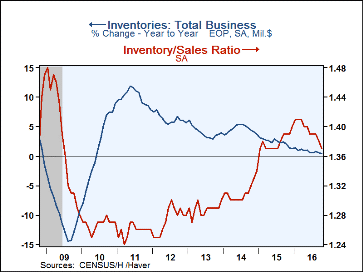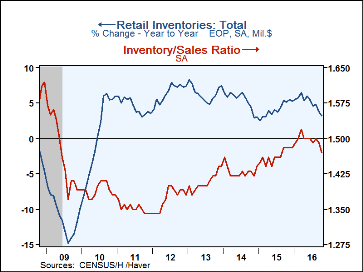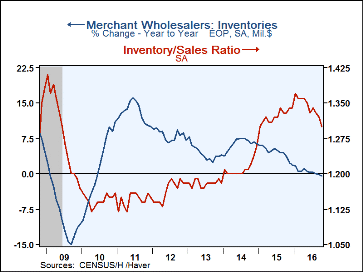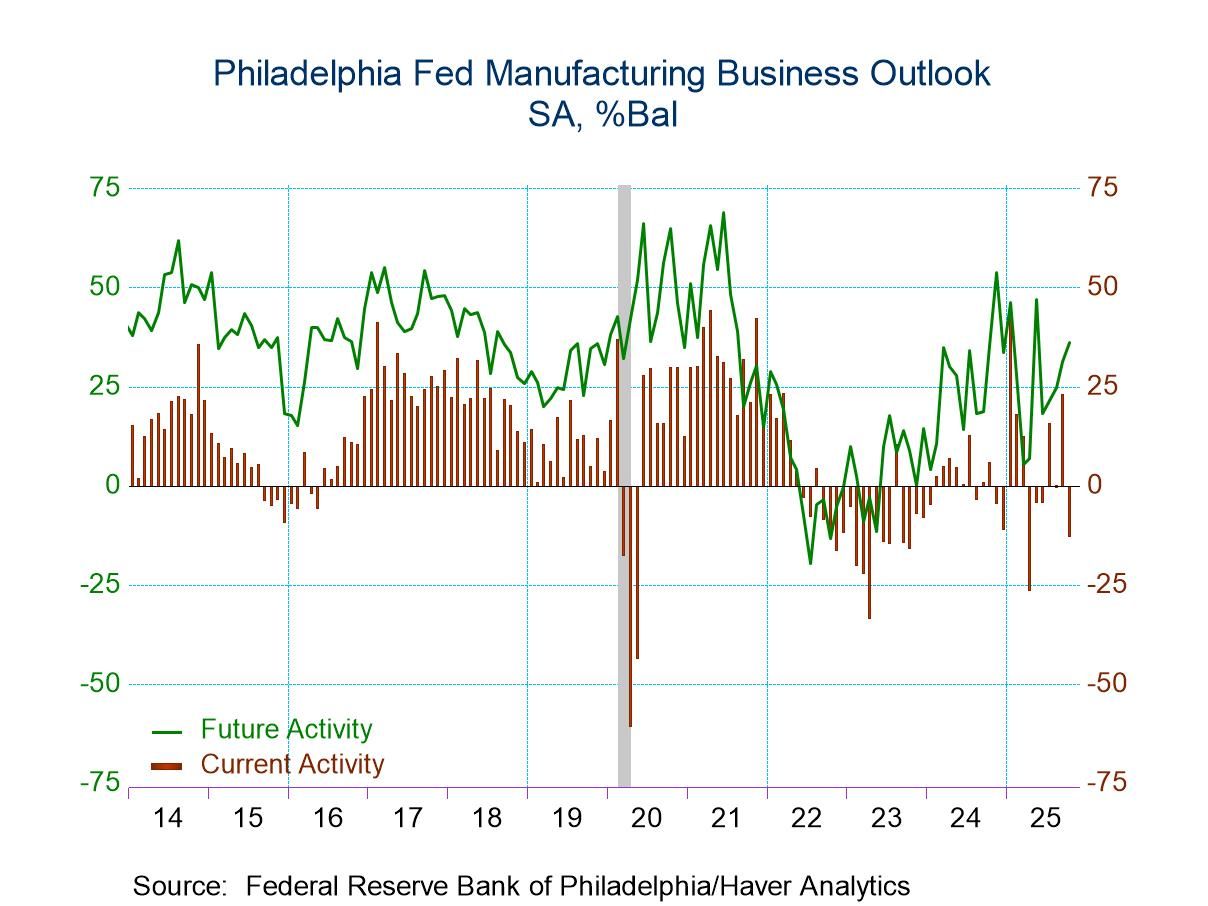 Global| Dec 14 2016
Global| Dec 14 2016U.S. Business Inventories Fall While Sales Improve
by:Tom Moeller
|in:Economy in Brief
Summary
Total business inventories declined 0.2% during October (+0.4% y/y) following no change in September, revised from a 0.1% increase. New data in this report showed that retail inventories declined 0.4% (+3.3% y/y) following no change. [...]
Total business inventories declined 0.2% during October (+0.4% y/y) following no change in September, revised from a 0.1% increase.
New data in this report showed that retail inventories declined 0.4% (+3.3% y/y) following no change. The decline was led by a 1.0% drop (-2.4% y/y) in furniture & electronics inventories. Motor vehicle inventories declined 0.7% (+7.9% y/y), while general merchandise inventories fell 0.6% (-2.8% y/y). Apparel inventories eased 0.1% (+0.5% y/y), but building materials inventories gained 0.3% (3.4% y/y). Wholesale inventories declined 0.4% (-0.4% y/y) and factory inventories were unchanged (-1.4% y/y).
Business sales increased 0.8% in October (2.1% y/y) as they did in the prior month. Retail sales increased 0.7% (4.1% y/y) while wholesale trade sales rose 1.4% (2.2% y/y). Factory shipments improved 0.4% both m/m and y/y.
The overall business inventory-to-sales ratio eased m/m to 1.37, and was down versus one year earlier. The retail I/S ratio fell to 1.47, while the ratio excluding autos also eased to 1.25. The wholesale sector I/S ratio fell to 1.30, and it was stable at 1.34 in the factory sector.
The manufacturing and trade data are in Haver's USECON database.
| Manufacturing & Trade | Oct | Sep | Aug | Oct Y/Y | 2015 | 2014 | 2013 |
|---|---|---|---|---|---|---|---|
| Business Inventories (% chg) | -0.2 | 0.0 | 0.2 | 0.4 | 1.3 | 3.7 | 3.9 |
| Retail | -0.4 | 0.0 | 0.6 | 3.3 | 5.3 | 3.1 | 7.4 |
| Retail excl. Motor Vehicles | -0.2 | -0.1 | 0.3 | 0.9 | 4.1 | 2.6 | 4.8 |
| Merchant Wholesalers | -0.4 | 0.1 | -0.1 | -0.4 | 1.9 | 6.5 | 4.0 |
| Manufacturing | 0.0 | -0.1 | 0.1 | -1.4 | -2.6 | 1.8 | 1.0 |
| Business Sales (% chg) | |||||||
| Total | 0.8 | 0.8 | 0.3 | 2.1 | -2.6 | 2.8 | 2.9 |
| Retail | 0.7 | 1.0 | -0.1 | 4.1 | 1.6 | 3.9 | 3.8 |
| Retail excl. Motor Vehicles | 0.8 | 0.8 | -0.1 | 3.9 | 0.2 | 3.2 | 2.6 |
| Merchant Wholesalers | 1.4 | 0.4 | 0.7 | 2.2 | -4.3 | 3.6 | 3.1 |
| Manufacturing | 0.4 | 0.9 | 0.2 | 0.4 | -4.4 | 1.2 | 2.1 |
| I/S Ratio | |||||||
| Total | 1.37 | 1.38 | 1.39 | 1.39 | 1.38 | 1.31 | 1.29 |
| Retail | 1.47 | 1.49 | 1.50 | 1.48 | 1.46 | 1.43 | 1.41 |
| Retail excl. Motor Vehicles | 1.25 | 1.26 | 1.27 | 1.29 | 1.27 | 1.24 | 1.23 |
| Merchant Wholesalers | 1.30 | 1.32 | 1.33 | 1.33 | 1.32 | 1.21 | 1.18 |
| Manufacturing | 1.34 | 1.34 | 1.35 | 1.36 | 1.36 | 1.31 | 1.30 |
Tom Moeller
AuthorMore in Author Profile »Prior to joining Haver Analytics in 2000, Mr. Moeller worked as the Economist at Chancellor Capital Management from 1985 to 1999. There, he developed comprehensive economic forecasts and interpreted economic data for equity and fixed income portfolio managers. Also at Chancellor, Mr. Moeller worked as an equity analyst and was responsible for researching and rating companies in the economically sensitive automobile and housing industries for investment in Chancellor’s equity portfolio. Prior to joining Chancellor, Mr. Moeller was an Economist at Citibank from 1979 to 1984. He also analyzed pricing behavior in the metals industry for the Council on Wage and Price Stability in Washington, D.C. In 1999, Mr. Moeller received the award for most accurate forecast from the Forecasters' Club of New York. From 1990 to 1992 he was President of the New York Association for Business Economists. Mr. Moeller earned an M.B.A. in Finance from Fordham University, where he graduated in 1987. He holds a Bachelor of Arts in Economics from George Washington University.










